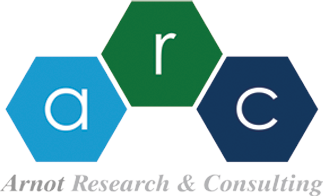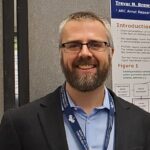OUR PERSONNEL

Jon Arnot, PhD
Jon Arnot is the President of ARC Arnot Research & Consulting based in Toronto, Canada. Jon is an adjunct professor in the Department of Physical and Environmental Science and in the Department of Pharmacology and Toxicology at the University of Toronto. He has 25 years of experience in the development, application, and evaluation of databases, methods, and models to assess the exposure, hazard, and risk of organic chemicals to humans and the environment. Jon has co-authored over 100 peer-reviewed papers and over 90 technical reports for government and industry. He has led the development of chemical fate mass balance models for outdoor and indoor environments, physiologically-based biokinetic (PBK) and bioaccumulation models and Quantitative Structure-Activity Relationships (QSARs). He has co-developed databases and models used by regulatory agencies in Canada (Environment Climate Change Canada, Health Canada), United Kingdom Environment Agency and in the US EPA’s ExpoCast program.
Dr. Arnot served on the United States National Academies of Sciences, Engineering, and Medicine Committee on incorporating 21stCentury Science into Risk-Based Evaluations (2015-2016) and Canada’s Chemicals Management Plan Science Committee (2017-2020). He is the principal investigator or co-investigator of various projects including collaborations with government and industry scientists in the United States, Europe, and Canada. He has developed and conducted workshops and training sessions for competent authorities at Environment and Climate Change Canada and Health Canada and at the European Chemicals Agency. Dr. Arnot holds a PhD in Environmental and Life Sciences from Trent University, an MSc from Simon Fraser University, and a BSc from the University of Alberta.
COLLABORATORS
Li Li, PhD
(MITACs Post-Doctoral Fellow University of Toronto Scarborough with Professor Frank Wania)
Dr. Li Li obtained his doctoral degree in environmental sciences from Peking University, China, in June 2017 and has since been a postdoctoral fellow at the University of Toronto Scarborough. Dr. Li has interdisciplinary expertise in environmental chemistry, industrial ecology and human exposure science. Over the past five years, he has developed and applied several mechanistic models that support holistic and mechanistic investigations for chemical exposure pathways from initial production to internal doses including: emissions from the human socioeconomic system, transport and transformation in indoor, urban, and rural environments, to exposure rates and toxicokinetics in higher various organisms, including humans. Examples of recent research in the development, testing and application of novel tools to support human health risk assessment include:
- an anthropospheric chemical fate model (CiP-CAFÉ, 2016), which describes the emission dynamics of a chemical in response to human socioeconomic activities such as production, use, waste disposal and international trade;
- a modeling continuum assembling substance flow analysis, environmental fate and transport modeling, food-chain bioaccumulation modeling as well as human toxicokinetic modeling. This system links human exposure and health impacts with chemical production/consumption and enables the evaluation of regulatory policy on chemical, article and product production, use and/or waste on human and ecosystem health;
- a parameter-parsimonious high-throughput screening model that supports efficient and reliable appraisal of human chemical exposure and potential health impacts based on readily available basic inputs such as chemical tonnage in commerce and molecular structure.
Dr. Li has published more than 20 peer-reviewed papers in internationally recognized journals (12 as lead author) on the topics of chemical fate, exposure and risk. Dr. Li has authored a monograph in a forthcoming textbook for modeling the fate of chemicals in consumer products. In addition to the academic and research excellence, he is also devoted to public service and outreach. He was a contributing author to the Update to China’s National Implementation Plan of the Stockholm Convention by China’s Ministry of Environmental Protection in 2016, and a part-time contract consulting scientist of the Greenpeace Detox Outdoor project on toxic perfluoroalkyl substances from 2015 to 2016. During his doctoral education in China, he also worked as a part-time assistant consultant in a Chinese consulting company, Jingqing Tech, Co., responsible for preparing risk assessment reports and notifications of new chemical substances for top Chinese and oversea chemical industries to be in compliance with the EU’s REACH (Registration, Evaluation, Authorisation and Restriction of Chemicals) and the China’s Provision on the Environmental Administration of New Chemical Substances (the “MEP Order No.7”).
Dr. Li is now an Assistant Professor at the University of Nevada Reno.
Frank Wania, PhD
Dr. Frank Wania is a Professor in the Department of Physical and Environmental Sciences, University of Toronto Scarborough and is affiliated with the graduate Departments of Chemistry and Chemical Engineering and Applied Chemistry, University of Toronto.
Dr. Wania has worked on the development, evaluation and application of environmental fate and transport models for 20 years.
His research interests currently include the development and application of novel air sampling techniques for semi-volatile organic contaminants, the understanding of differences in contaminant accumulation along climatic gradients, the identification of new environmental contaminants by theoretical means, the quantification of the role of snow in the environmental fate of pollutants, and the model-based exploration of differences in human exposure to bioaccumulating substances.
More details about Frank and his research group, including current projects are available at his homepage at the
University of Toronto Scarborough website.
.
ALUMNI
James M. Armitage, PhD
Dr. James M. Armitage received a Masters of Resource Management (MRM) degree from Simon Fraser University in 2004 and a PhD specializing in the field of Applied Environmental Science from Stockholm University (Stockholms Universitet) in 2009. The research project during his Masters degree focused on the development of toxicokinetic (bioaccumulation) models for neutral organic chemicals in terrestrial (air-breathing) organisms, namely: worms, small mammals and birds. Dr. Armitage’s PhD research focused on the fate and transport of perfluoroalkylated substances (PFAS) and the implications for human and ecological exposure and risk. Dr. Armitage was employed as a Banting Post-Doctoral Fellow and then a Research Associate in the Department of Physical & Environmental Sciences at the University of Toronto from 2011-2018 and is currently the President and Principal Researcher at AES Armitage Environmental Sciences, Inc. He has 15 years of experience in the development, application, and evaluation of methods and in silico models to assess the exposure, hazard, and risk of organic chemicals to humans and the environment. Current research interests include i) physiologically-based toxicokinetic model development for humans and other mammals, particularly for parent/metabolite combinations and ionogenic organic chemicals and ii) continued development of novel tools to facilitate the use of in vitro toxicity data for risk assessment. He has provided technical expertise to both Environment and Climate Change Canada (ECCC) and Health Canada through workshops and external peer review of white papers and Draft Screening Assessment Reports generated by these agencies.
Dr. Armitage has been collaborating closely with Dr. Arnot for more than a decade on various projects and publications on ecological and human exposure to organic chemicals. With respect to the provision of scientific expertise in the development and application of tools in support of human health risk assessment, two notable recent contributions led by Dr. Armitage are i) the development of a mercury exposure assessment tool for humans funded by the Northern Contaminants Program (MEAT v2.0) and ii) the development of a mass balance model to facilitate the use of in vitro toxicity data for human health and ecological risk assessment (“IV-MBM”; 2014). The MEAT v2.0 model allows the user to estimate the human body burden of methylmercury associated with a given dietary exposure scenario and then compares this output to established thresholds for human health risk assessment. The tool also allows the user to enter data on nutrient contents of ingested food items and then sums and compares these values to recommended daily intakes. The development evaluation and application of IV-MBM is particularly relevant given the prominence of emerging in vitro bioassay data such as those generated in the ToxCAST and Tox21 programs (www.epa.gov/chemical-research/toxicity-forecasting) in the United States and similar efforts in Europe (eurl-ecvam.jrc.ec.europa.eu) and the utilization of these data in human health assessment. IV-MBM is being used by regulatory agencies (EPA, NTP) in the United States (e.g., Casey et al., Environ Health Persp 2018).
Todd Gouin, PhD
Dr. Todd Gouin received a PhD specializing in the field of environmental chemistry from Trent University through the Watersheds Ecosystems Graduate Programme in June 2006. Following his graduate studies, Dr. Gouin, has obtained both experimental and modelling experience in assessing diverse chemical exposures including current use pesticides in Costa Rica and polycyclic aromatic hydrocarbons in Arctic regions of Alaska.
More recently Dr. Gouin was employed for eight years by Unilever, a multi-national company specializing in the development and sale of personal care and cleaning products. While at Unilever his expertise was used in assessing human and environmental risks associated with chemicals used in a variety of product types. Like most large personal care companies, Unilever has a strong commitment towards the development of non-animal risk assessment approaches and the research Dr. Gouin was involved with supported that initiative. During his time at Unilever, Dr. Gouin was involved in the development and application of tools aimed at both screening and prioritization of chemicals and higher-tier risk assessment. Knowledge and tools developed to support human health risk assessment include supporting the development of (i) an adverse outcome pathway for skin sensitization, (ii) involvement in the development and application of a mechanistically-based skin permeation mode and (iii) characterization of chemical use and release information for chemicals used in developing markets, such as in China, and for specific chemicals, such as for the cyclic volatile organosiloxanes.
Furthermore, Dr. Gouin provided support to the development of high-throughput in vitro modelling tools, providing technical support to a Unilever-US EPA collaboration aimed at demonstrating the utility of in vitro data to support the human risk assessment of chemicals used in personal care products. Dr. Gouin also provided technical expertise on several industry trade association activities associated with risk assessment, including:
- European Centre for Ecotoxicology and Toxicology of Chemicals (ECETOC), where he chaired and contributed to industry-led task forces on the development and application of risk assessment tools for challenging chemicals, such as ionizable organics and particles, i.e., nanomaterials and microplastic, and sparingly soluble chemicals including those associated with Unknown or Variable Composition, Complex Reaction Products and Biological Materials (UVCBs).
- ECETOC research program monitoring committee for the European Chemical Industry Councils long-range research initiative (CEFIC-LRI) for projects encompassing a range of subject matter relevant to human and ecological risk assessment:
- ECO36 “Paving the way for QIVIVE – from nominal to free to cellular concentrations in in vitro assays” 2017-2019.
- ECO34 “A tiered testing strategy for rapid estimation of bioaccumulation by a combined modelling – in vitro testing approach” 2016-2019.
- ECO33 “Strengthening the use and interpretation of dietary bioaccumulation tests for hydrophobic chemicals” 2016-2017.
- ECO30 “Mining data(bases) to expand the domain of applicability of chemical activity” 2015-2018.
- ECO21 “Improving the performance and expanding the applicability of a mechanistic bioconcentration model for ionogenic organic compounds (IOCs) in fish (BIONIC)” 2013-2016.
- Research team member of LRI-B13 “Development of an in silico model for dermal absorption” (2014-2016).
- Cosmetics Europe, where he contributed to the development and application of skin permeation models and tools to address challenging substances;
- Personal Care Products Council, where he contributed technical expertise in the development of a risk assessment framework for microplastic particles.
Dr. Gouin is now the President of TG Environmental Research and collaborates closely with Dr. Arnot and colleagues at ARC. He continues to provide technical support to industry activities at CEFIC, ECETOC, and the International Council of Chemical Association (ICCA) related to chemical risk assessment for both humans and the environment. Current research interests include the development and application of risk assessment methods for particulates, such as microplastic particles, nanomaterials, and UVCBs, as well as the development and use of skin permeation models that account for dynamic use scenarios product formulation.
Lauren Hughes, MSC
Lauren Hughes received a MSc in chemical physics from Dalhousie University and began working with Don Mackay at the Canadian Environmental Modelling Centre in 2003. Her modeling research has focused on chemical fate and transport from agricultural soils, including plant uptake, and accumulation in terrestrial food chains and in adjacent aquatic systems. Ms. Hughes has been involved in the development and coding of several chemical fate models including the Biosolids-Amended Soil: Level 4 (BASL4) model that examines the fate of chemicals introduced to soil environments through contaminated sludge amendments and the AGRO pesticide fate and exposure model. She has also been extensively involved in the development and testing of the RAIDAR-ICE model and revisions to RAIDAR and FHX software and the EQC model.
Alexandra Looky, BSc
Ms. Alexandra Looky received her BSc in Biochemistry (with a Biotechnology option) from the University of Waterloo in 2005. In 2010 she received a Graduate Certificate in Bioinformatics from Seneca College. Her current research interests are in environmental toxicology. Ms. Looky aims to use her scientific background and her programming and database skills to analyze large sets of data and build substantial databases. These databases are intended for applications in the parameterization of toxicokinetic models and the development and evaluation of QSAR models for hazard, exposure and risk assessment. Her preferred informatics tools are R, Python and MYSQL and she has extensive experience with Excel. Recent collaborative projects with ARC include the collection of in vitro and in vivo biotransformation rate databases of pharmaceutical and environmental compounds in humans.
Don Mackay, PhD
Dr. Don Mackay is Director Emeritus of the Centre for Environmental Modelling and Chemistry at Trent University. He is Professor Emeritus at Trent University and the University of Toronto. The principal activities are (i) compilation of physical chemical data on organic contaminants, (ii) development of models describing the environmental fate and effects of chemical contaminants and (iii) various studies relating to policies for chemical management in the environment.
He is the author or co-author of over 600 research papers, articles, book chapters and technical reports, including over 300 peer-reviewed publications and author, editor or co-editor more than a dozen books.
More details about Don and his research are available at his homepage at the
Canadian Centre for Environmental Modelling and Chemistry (CEMC) website.
Lynn McCarty, PhD
He has spent over 30 years examining various aspects of toxicology and environmental contamination, with emphasis on the aquatic environment.
He has been involved in numerous projects examining actual and potential effects for a wide variety of contaminants in an assortment of situations. This included the preparation of a number of air and water quality guidelines for the Ontario and Canadian Governments.
As well, he carried out critical reviews of various environmental quality guidelines, protocols, and risk assessments, for, among others, Environment Canada (including CEPA), the Canadian Council of Ministers of the Environment (CCME), and the U.S. Environmental Protection Agency. In 2005 Dr. McCarty was a member of the U.S. EPA Science Advisory Board Aquatic Life Criteria Consultative Panel.
Dr. McCarty has been an involved in a number of risk assessment projects and also provided expert witness testimony. These include: effects associated with the siting and operation of domestic and hazardous waste treatment facilities (sewage, landfill, and incineration); siting and operation of nuclear and hydroelectric power stations, effects of liquid and solid wastes from pulp and paper mills, effects of past, current, and proposed mining operations; effects associated water, sediment, and soil contamination by petroleum products; and effects of pesticides in agriculture and forestry. Also, reports for FIFRA and UN ECE POP RC evaluation have been prepared.
Dr. McCarty has been an invited expert at a number of workshops and expert panels sponsored by CNTC, Health Canada, SETAC, US EPA, and US Army Corps of Engineers examining, employing, and/or developing environmental quality guidelines, and risk assessments.
Included in the over 60 peer-reviewed publications is co-authorship of two chapters in the second edition of the standard reference book “Fundamentals of Aquatic Toxicology” (Rand, 1995). As well, several of his publications are commonly cited by regulatory agencies around the world in various protocols, guidelines, and regulations.
He continues to publish in the primary scientific literature, make presentations at professional scientific meetings, and currently serves on the editorial board of Human and Ecological Risk Assessment. The Province of Ontario recognized his scientific work by awarding him the Ontario MOE Excellence in Research – Water Quality in 1990.



